How to Do Safe Stretches for Knee Pain: A Gentle Guide for Better Mobility
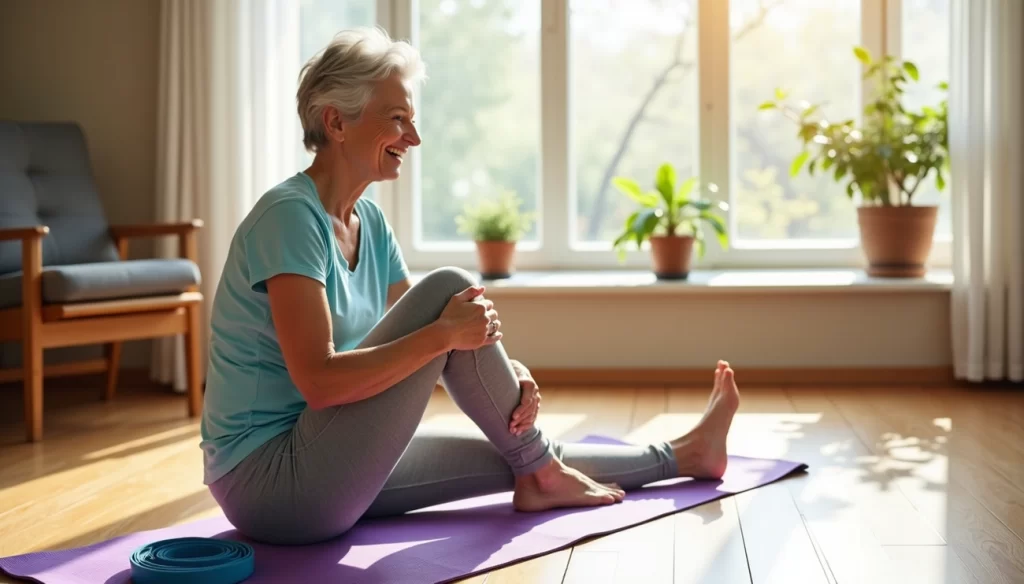
Why stretches for knee pain? Forty percent of people over 70 develop osteoarthritis—a condition where joint cartilage (the smooth tissue covering bone ends) gradually wears down—with knee problems representing Singapore’s most prevalent age-related musculoskeletal concern.1
The idea of stretching when your knee already hurts may feel counterproductive, yet movement serves your joint far better than rest.2 Tight muscles surrounding the knee frequently cause or worsen pain, creating a problem that targeted stretches for knee pain can effectively address.3 Weight also plays a crucial role: each extra pound places additional stress on your knees, potentially accelerating cartilage deterioration and intensifying discomfort.4
This guide examines proven stretches for knee pain and relief exercises designed to enhance mobility whilst reducing discomfort. Stiffness, pain, or swelling—especially after age 50—often signal osteoarthritis development.3 Though we cannot undo these structural changes, pain reduction becomes achievable through strengthening muscles around the knee, pelvis, and core.3 Research demonstrates that stretching and strengthening exercises targeting knee-supporting muscles can ease pain, expand range of motion, and lower future injury risk.2
Why Movement Matters for Knee Health
Your knee stands as the body’s largest and most complex joint, functioning as the vital bridge between your thigh and lower leg. This remarkable structure’s intricate design demonstrates exactly why movement remains essential for maintaining knee health, particularly when pain strikes.
The role of joints and muscles in knee function
Functioning primarily as a hinge joint, your knee enables flexion and extension whilst supporting your entire body weight during standing and movement5. This sophisticated joint connects your thighbone (femur) to your shinbone (tibia), incorporating cartilage, ligaments, and an intricate network of muscles that collaborate to facilitate walking, running, and jumping6.
The muscles encircling your knee function as “dynamic stabilisers”—active support systems that maintain joint integrity throughout movement7. Key players include the hamstrings (flexor muscles at the back of your thigh) and quadriceps (extensor muscles at the front)5. Weakness in these muscle groups forces your knee joint to absorb extra stress, potentially hastening cartilage breakdown and amplifying pain levels.
How inactivity worsens knee pain
Rest might appear logical for knee pain relief, yet inactivity frequently exacerbates the condition. Regular movement allows synovial fluid—your joint’s natural lubricant—to circulate properly and nourish cartilage tissue8. Without this circulation, cartilage develops a porous, rough texture, leading to continuous wear and diminished protective capacity.
Evidence reveals that reduced use of leg muscles, ligaments, and joints during moderate activity results in progressive weakening9. This pattern creates a damaging cycle: pain restricts movement, restricted movement increases joint stiffness, and increased stiffness generates more pain whilst accelerating joint breakdown10.
Benefits of gentle movement
Appropriate, regular movement delivers several advantages for knee health:
- Improved circulation – Gentle exercises boost blood flow to joint tissues, supplying vital nutrients whilst removing inflammatory substances10
- Enhanced lubrication – Movement supports synovial fluid production and distribution, promoting smoother joint motion10
- Muscle strengthening – Exercise training effectively increases muscle cross-sectional area, enhancing joint support capacity11
- Pain reduction – Systematic reviews of randomized trials demonstrate that exercise significantly reduces pain whilst improving physical function and quality of life11
Your joints evolved for movement. Regular physical activity alleviates pain and stiffness, strengthens supporting musculature, and enhances balance to reduce fall and injury risks4.
Effective Stretches for Knee Pain Relief at Home
Gentle stretching provides one of the most practical approaches to managing knee discomfort from home. These targeted stretches for knee pain address key muscle groups surrounding your knee joint, enhancing flexibility whilst reducing muscular tension. Four straightforward yet highly effective stretches can easily become part of your daily routine.
Seated hamstring stretch
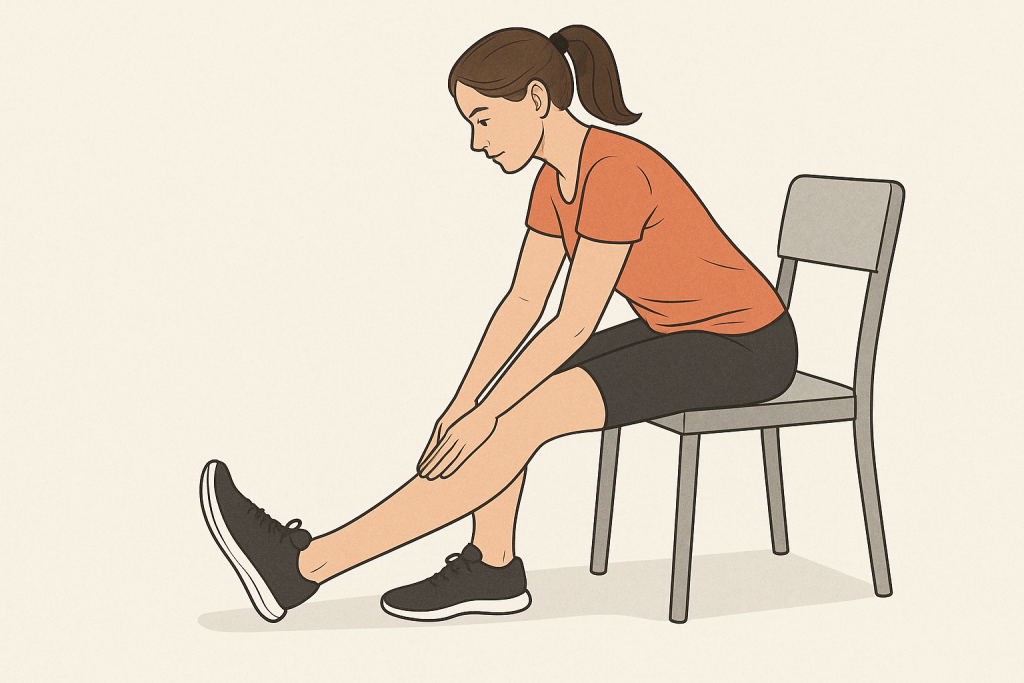
Hamstring muscles—the three muscles running down your thigh’s back—often contribute to knee discomfort when tight. This seated approach offers excellent control:
- Sit at a chair’s edge with one leg extended straight ahead, heel grounded and toes pointing upward
- Maintain a straight back and place hands on your thigh for support
- Slowly hinge forward from your hips until you feel a gentle stretch along your thigh’s back
- Hold this position for 20-30 seconds without bouncing motions
- Return to starting position and repeat with your opposite leg
Perform this stretch 2-3 times per leg daily for optimal results. This seated hamstring stretch is one of the most effective stretches for knee pain when done consistently.
Standing quadriceps stretch
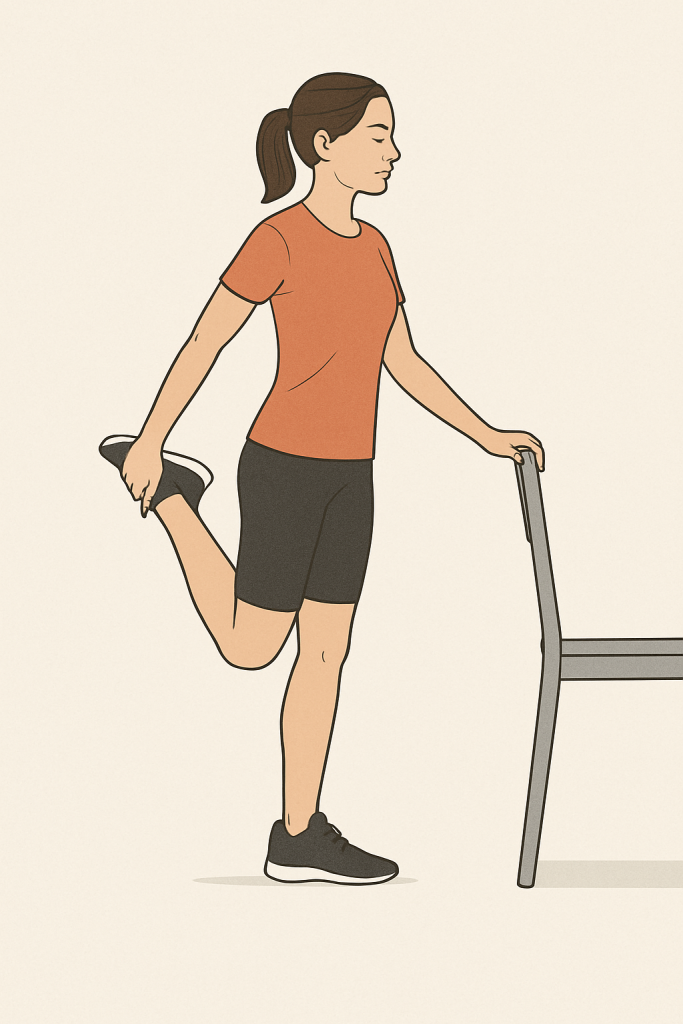
The quadriceps—four muscles at your thigh’s front—help stabilize your knee during movement. Proper stretching technique involves:
- Stand upright near a wall or chair for balance support
- Bend one knee and grasp your ankle with your hand
- Pull your heel gently toward your buttocks until you feel stretching in your thigh’s front
- Keep knees close together and avoid back arching
- Hold for 30 seconds, then slowly lower your foot
- Repeat on your opposite leg
Among the most recommended stretches for knee pain, the standing quadriceps stretch supports knee stability and reduces muscle tightness. Complete this stretch 2-3 times per leg.
Wall calf stretch
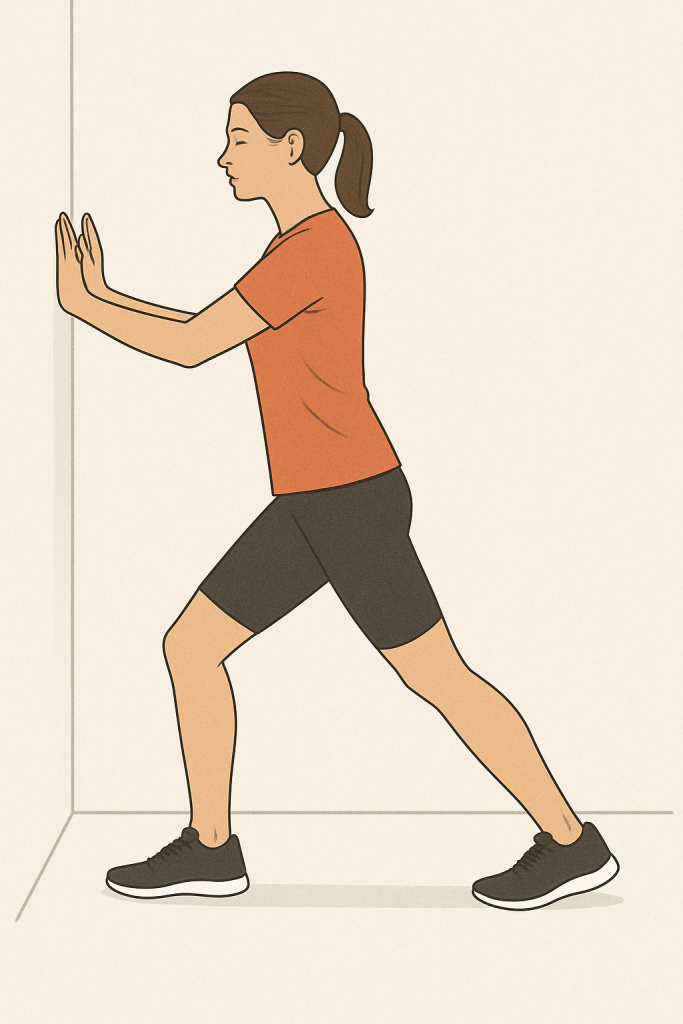
Tight calf muscles—the muscles in your lower leg’s back—can significantly affect knee function and comfort. An effective approach requires:
- Stand facing a wall with hands positioned at shoulder height for support
- Step one foot backward, keeping both heels flat against the floor
- Bend your front knee slightly whilst maintaining your back leg straight
- Lean forward until you feel stretching in your back leg’s calf
- Hold for 30 seconds without bouncing
- Switch legs and repeat
The wall calf stretch is another valuable option in your routine of stretches for knee pain, improving calf flexibility and ankle mobility to indirectly support knee comfort.
Supine leg raise with strap
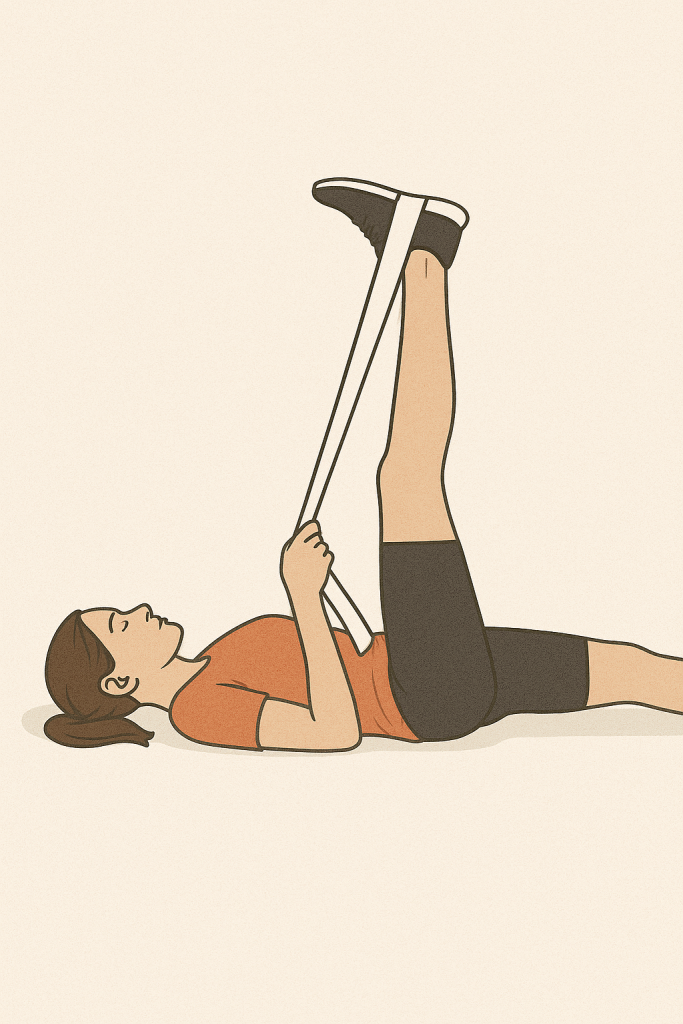
This gentle technique improves hamstring flexibility whilst lying down:
- Lie on your back with both legs straight
- Loop a stretching strap, towel, or belt around one foot
- Keep your leg straight and use the strap to gently pull your leg upward
- Raise until you feel comfortable stretching along your leg’s back
- Hold for 30-60 seconds before lowering
- Repeat with your other leg
Breathe normally throughout each stretch and never push beyond comfortable limits.
Safety Guidelines for Stretches for Knee Pain
Technique matters significantly when performing stretches for knee pain. Well-intentioned movements become harmful without proper execution, making these safety principles essential for protecting your joints whilst maximising therapeutic benefits.
Listen to your body’s signals
Preparation prevents problems. Warm up with 5-10 minutes of gentle activity such as walking before beginning any stretching routine12. Your body provides constant feedback through physical sensations—these signals deserve attention. Sharp pain indicates potential harm13. Pain serves as your body’s warning system, signalling when you’ve exceeded safe limits12. Target a gentle pulling sensation rather than discomfort14. Consider rating your pain from 0-10, keeping sensations below level 515.
Support yourself properly
Stability enhances both safety and effectiveness during stretches. Grip a chair or wall for balance when performing standing exercises16. Straps, towels, or belts assist with hamstring stretches, helping you maintain correct positioning without excessive strain2. Supportive equipment like knee straps or insoles can provide additional alignment and stability during movement17.
Move with control and purpose
Bouncing during stretches risks muscle injury and may increase tightness rather than reducing it14. Smooth, deliberate movements yield better results13. Each stretch benefits from 20-30 seconds of sustained, comfortable tension whilst maintaining normal breathing patterns14. Concentrate on form over intensity, executing movements slowly and purposefully13. Master proper technique before progressing to prevent unnecessary strain17.
Maintain balanced flexibility
Symmetrical flexibility proves more valuable than exceptional range of motion on one side14. Imbalanced flexibility between limbs may elevate injury risk14. Naturally, one side often feels tighter—address this by holding stretches slightly longer on the restricted side18. Work both legs equally, focusing on steady breathing to enhance each stretch’s effectiveness19.
Lifestyle Habits That Support Knee Mobility
Stretching alone cannot address all factors affecting knee health. Certain lifestyle modifications can significantly enhance your mobility whilst reducing pain, creating a foundation that supports your exercise routine.
Maintain a healthy weight
Every extra pound adds 3-5 times more pressure on your knees during daily activities20. Individuals carrying excess weight face nearly 4-5 times greater risk of developing knee osteoarthritis—the wear-and-tear condition affecting joint cartilage21. The encouraging news? Losing just 10% of body weight can reduce knee pain by up to 50% in people with osteoarthritis22.
Choose supportive footwear
Footwear selection plays a critical role in knee health maintenance. Quality shoes should feature firm arch support to maintain foot alignment, adequate cushioning for shock absorption, and heel stabilisation to prevent excessive ankle motion23. High heels create additional knee stress and may elevate osteoarthritis risk, making them unsuitable for those with knee concerns4. Orthopaedic shoes or custom inserts offer alignment support for individuals with specific foot conditions.
Incorporate low-impact cardio like walking or swimming
Swimming provides cardiovascular benefits without joint stress due to water buoyancy—the upward force that reduces body weight in water20. Short brisk walks lasting 5-10 minutes throughout the day deliver comparable benefits to longer sessions whilst minimising joint strain20. Cycling effectively strengthens quadriceps and hamstrings, the primary muscle groups responsible for knee stability24.
Practise good posture daily
Proper body alignment reduces unnecessary knee joint stress. Seated posture requires feet flat on the floor with knees positioned at hip height or slightly below4. Standing posture demands even weight distribution between both feet whilst avoiding leg crossing25. Core-strengthening exercises such as planks support optimal posture, indirectly protecting knee joints from misalignment stress25.
Conclusion
Knee pain undoubtedly creates daily challenges, particularly with advancing age, yet appropriate stretching provides genuine pathways to relief. This guide has demonstrated how gentle, consistent stretches for knee pain—rather than prolonged rest—supports knee health through improved circulation, enhanced synovial fluid distribution (the natural lubricant within joints), and stronger supporting musculature. These physiological improvements translate into better joint function and decreased discomfort.
The stretches presented—spanning seated hamstring stretches through supine leg raises—offer accessible techniques for managing knee pain at home. Most importantly, approach each movement with awareness and respect for your body’s signals. Sharp pain during stretching serves as a clear warning that you’ve exceeded safe limits.
Complementing your stretching routine with thoughtful lifestyle modifications amplifies results considerably. Weight management reduces mechanical stress on knee joints, whilst supportive footwear maintains proper alignment during daily activities. Low-impact cardiovascular exercise such as swimming or walking builds muscular strength without compromising vulnerable joint structures.
Though knee pain may seem restrictive, these evidence-based approaches can produce meaningful improvements in mobility and comfort. Progress requires patience and consistency rather than aggressive effort. Each gentle stretch represents progress toward enhanced knee health and sustained independence in your daily activities.
Key Takeaways
These essential insights will help you safely manage knee pain through gentle movement and smart lifestyle choices:
- Movement beats rest -Gentle stretches for knee pain improve joint lubrication and strengthens supporting muscles, whilst inactivity worsens stiffness and accelerates joint deterioration.
- Master four key stretches at home – Seated hamstring, standing quad, wall calf, and supine leg raises target crucial muscle groups around your knee for better flexibility.
- Follow safety-first principles – Start slowly, use support tools like chairs or straps, avoid bouncing movements, and stop if you feel sharp pain during stretches.
- Support stretches with smart lifestyle habits – Combine stretches for knee pain with weight management (every extra pound adds 3-5x pressure on knees), supportive footwear, and low-impact cardio.
- Consistency trumps intensity – Hold stretches for 20-30 seconds, perform 2-3 times per leg daily, and focus on gradual improvement rather than pushing through pain.
Remember, losing just 10% of body weight can reduce knee pain by up to 50% in people with osteoarthritis, making these gentle approaches particularly powerful when combined with healthy lifestyle choices.
Disclaimer
The information provided in this guide on stretches for knee pain is for general educational purposes only. It is not a substitute for professional medical advice, diagnosis, or treatment. Always consult a qualified healthcare provider before beginning any new exercise program, especially if you have an existing injury, medical condition, or persistent knee pain. Never ignore or delay seeking professional advice because of something you have read here.
FAQs
Q1. Is stretching beneficial when experiencing knee pain?
Yes, gentle stretching can be highly beneficial for knee pain. Regular stretching helps improve joint lubrication, increases flexibility, and strengthens the muscles supporting the knee. However, it’s crucial to perform stretches carefully and stop if you experience sharp pain.
Q2. What’s a common mistake people make when dealing with knee pain?
A common mistake is reducing movement due to knee pain. While it may seem counterintuitive, lack of movement can actually worsen knee problems by causing joint stiffness and muscle weakness. Gentle, controlled exercises are often better for knee health than complete inactivity.
Q3. Which exercises are most effective for managing knee pain?
Low-impact exercises like water aerobics, cycling, and walking are excellent for managing knee pain. These activities improve flexibility, strength, and range of motion without putting excessive stress on the knee joint. Yoga can also be beneficial for improving flexibility around the knee area.
Q4. How can lifestyle changes help improve knee mobility?
Several lifestyle changes can significantly improve knee mobility. Maintaining a healthy weight reduces pressure on the knees, wearing supportive footwear helps with joint alignment, and practising good posture reduces stress on knee joints. Additionally, incorporating low-impact cardio exercises into your routine can strengthen the muscles supporting your knees.
Q5. What are some safe stretches for knee pain that can be done at home?
Safe stretches for knee pain that can be done at home include the seated hamstring stretch, standing quad stretch, wall calf stretch, and supine leg raise with a strap. These stretches target key muscle groups around the knee, promoting flexibility and reducing tension. Remember to perform these stretches gently and consistently for the best results.
References
[1] – https://www.healthhub.sg/live-healthy/finding-ease-for-old-knees
[2] – https://www.healthline.com/health/exercises-for-knee-pain
[3] – https://www.health.harvard.edu/pain/take-control-of-your-knee-pain
[4] – https://www.arthritis.org/health-wellness/healthy-living/managing-pain/joint-protection/tips-for-healthy-knees
[5] – https://my.clevelandclinic.org/health/body/24777-knee-joint
[6] – https://www.uclahealth.org/news/article/how-exercise-keeps-knees-healthy-you-age
[7] – https://www.ncbi.nlm.nih.gov/books/NBK500017/
[8] – https://www.bauerfeind-group.com/en/health/osteoarthritis-joint-wear/inactivity-and-its-consequences
[9] – https://noyeskneeinstitute.com/inactivity-hard-knees/
[10] – https://www.activtherapy.com.au/blog/why-gentle-movements-are-important-for-arthritic-joint-health
[11] – https://pmc.ncbi.nlm.nih.gov/articles/PMC8716769/
[12] – https://www.mayoclinic.org/healthy-lifestyle/fitness/in-depth/stretching/art-20546848
[13] – https://www.hipkneeortho.com.sg/easy-hotel-room-exercises-for-knee-recovery/
[14] – https://www.mayoclinic.org/healthy-lifestyle/fitness/in-depth/stretching/art-20047931
[15] – https://www.nhsinform.scot/illnesses-and-conditions/muscle-bone-and-joints/leg-and-foot-problems-and-conditions/exercises-for-knee-problems
[16] – https://www.sgpainsolutions.com/general-health-tips/knee-pain-relief-stretches-exercises/
[17] – https://medi-dyne.com/blogs/exercises/knee-exercises?srsltid=AfmBOooP7jyds_0f5UjDnZX7IRsV9wQqHvHLpwMcWXgLOGnSpJ6tukDt
[18] – https://www.healthline.com/health/full-body-stretch
[19] – https://unitedkneecenters.com/2025/04/09/knee-stretches-for-pain-relief/
[20] – https://www.health.harvard.edu/exercise-and-fitness/the-best-types-of-exercise-when-you-have-hip-or-knee-pain
[21] – https://www.hopkinsarthritis.org/patient-corner/disease-management/role-of-body-weight-in-osteoarthritis/
[22] – https://elevatephysio.com.sg/the-impact-of-weight-on-joint-health-a-physiotherapists-perspective/
[23] – https://myfootdr.com.sg/what-are-the-best-orthopaedic-shoes-for-knee-problems/
[24] – https://spinediagnostic.com/10-low-impact-exercises-to-relieve-knee-pain-and-improve-mobility/
[25] – https://www.kneepaincentersofamerica.com/blog/the-connection-between-knee-pain-and-posture-issues





